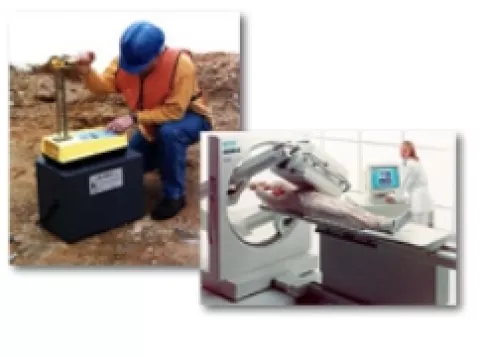Uranium Recovery
On this page:
What We Regulate
The nuclear fuel cycle is the process of removing uranium from the ground, converting it into nuclear fuel for use in commercial power reactors, and managing its storage and ultimate disposal as waste. Uranium recovery is the first step – removing uranium from the Earth and milling it to produce a product called “yellowcake” that becomes the basis of nuclear fuel.
Uranium recovery is typically accomplished in two ways:
- Conventional milling extracts uranium from ore excavated in deep underground shafts or shallow open pits (ie., mines); the ore is crushed and chemically treated to extract the uranium.
- In situ recovery (ISR) injects a liquid solution into the ore underground; the solution leaches uranium from the rock and is then pumped to the surface and processed.
The NRC becomes involved when the ore is chemically altered or processed – in other words, at the conventional mill or the ISR facility. The NRC does not regulate conventional mines. The NRC regulates ISR facilities, uranium mills, and the disposal of waste “tailings” in certain States, while State agencies regulate these activities in so-called “Agreement States”—States that have entered into strict agreements with NRC to regulate certain nuclear materials.
Currently, the NRC regulates active uranium recovery operations in New Mexico and Nebraska. Uranium recovery operations in Wyoming, Texas, Colorado, and Utah are regulated by state agencies, as they are Agreement States.
For additional information about what the NRC regulates in relation to uranium recovery, see Operating Uranium Recovery Facilities; License Applications for New Uranium Recovery Facilities, Expansions, Restarts, and Renewals; Sites Undergoing Decommissioning; and the following related pages:
How We Regulate
In accordance with its mission, the NRC focuses its regulatory actions on protecting the health and safety of the public and the environment during the active life of a uranium recovery operation and after the facility has been decommissioned. The NRC staff accomplishes this mission by performing the following activities:
- Develop regulations and guidance for the regulated community.
- Review license applications and amendments.
- Develop environmental assessments (EAs) and environmental impact statements (EISs) to support the agency's reviews.
- Inspect uranium recovery facilities.
- Review decommissioning plans and activities.
Uranium milling and disposal of the resulting waste byproduct material by NRC licensees are regulated under Title 10, Part 20, of the Code of Federal Regulations (10 CFR Part 20), "Standards for Protection Against Radiation"; 10 CFR Part 40, "Domestic Licensing of Source Material"; and Appendix A to 10 CFR Part 40. As its title implies, Appendix A sets forth the criteria relating to the operation of uranium mills and the disposition of tailings or wastes produced by the extraction or concentration of source material from ores processed primarily for their source material content. In general, these criteria require uranium recovery facilities to control industrial hazards and address waste and decommissioning concerns.
In general, the primary industrial hazards associated with uranium milling are the occupational hazards found in any metal milling operation that uses chemical extraction, as well as the chemical toxicity of the uranium itself. Because the uranium produced at these facilities is not enriched, there is no criticality hazard and little fire or explosive hazard. Radiological hazards are also low at these facilities, as uranium has little penetrating radiation and only moderate non-penetrating radiation. The primary radiological hazard is attributable to the presence of radium in the waste byproduct material (known as "mill tailings"). For additional information, see Uranium Mill Tailings and the Backgrounder on Uranium Mill Tailings.
For additional information about how we regulate uranium recovery operations, see the following related pages:
- Regulations, Guidance, and Communications
- License Applications for New Uranium Recovery Facilities, Expansions, Restarts, and Renewals
- Generic Environmental Impact Statement for In Situ Leach Uranium Milling Facilities
- Oversight of Licensed Uranium Recovery Operations
- Public Involvement
- Hearing Opportunities and License Applications
Page Last Reviewed/Updated Friday, March 31, 2023
Page Last Reviewed/Updated Friday, March 31, 2023


